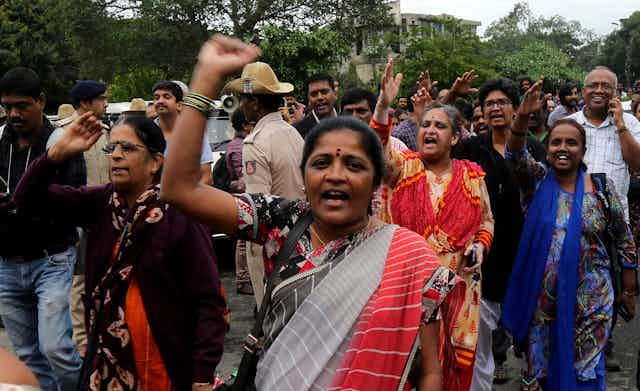Tensions are on the rise in Jammu and Kashmir, an Indian state situated mostly in the Himalayas. For decades, it has had constitutional autonomy from India.
The region is an area of major territorial conflict between India and Pakistan. Parts of the Kashmir valley have been under Pakistan’s control since the 1948 Indo-Pakistani war and both India and Pakistan have since fought two more wars claiming title to Jammu and the whole of Kashmir.
But the Indian Home Minister Amit Shah has announced the government’s decision to take away Jammu and Kashmir’s special status. This status gave it the independence to have its own constitution, flag and the ability to make its own laws for its residents.
Read more: India, Pakistan and the changing rules of engagement: here's what you need to know
To do this, the government has abolished Articles 370 and 35A of the Indian constitution, and announced a plan to divide the Indian state of Jammu and Kashmir into two union territories.
In recent weeks, India has discharged some 35,000 troops to the Indian parts of Kashmir, adding to the 500,000 troops already stationed in the territory. India also cancelled a major Hindu pilgrimage, asked tourists to leave and imposed curfews in parts of the state.
What’s more, major Jammu and Kashmir politicians, including two former chief ministers, have been arrested, schools and colleges have shut, and communication facilities have been suspended.
India cites the threat of militancy in the territory emanating from Pakistan as the reason for recent lockdown and security measures.
So what happens now?
From now on, Jammu and Kashmir will be considered a part of India in the same way as other Indian states. It will be subject to the Indian constitution in its entirety.
The Indian government, following its election promises, claims that removing the special status will provide better economic and political opportunities in Jammu and Kashmir, the same as those available in mainland India.
Read more: India Tomorrow part 3: Kashmir
But skeptics believe that such a rushed move is merely a cover for changing the demographics of the Muslim-majority Kashmir to make it more Hindu, in the same way Israel expanded into Palestinian territories.
The abolition of Article 35A removes a constitutional hurdle for foreigners to buy land, settle in Jammu and Kashmir and increase the non-Muslim population there.
Until now, the expansion of the non-Muslim population was restricted due to strict property, political and entrepreneurial state laws for non-residents.
What does Article 370 do?
Adopted in 1949, Article 370 grants Jammu and Kashmir an autonomous status under the Indian constitution.
The article exempts the state from the terms of the constitution and limits the Indian Parliament in making laws for Jammu and Kashmir, except on matters of defence, external affairs and communications.
The Jammu and Kashmir legislature must approve any other law the Indian Parliament passes before it takes effect.
The article states that specific provisions in the Indian constitution can be extended to Jammu and Kashmir through presidential orders. But this can only happen with the agreement of the state government.
One such provision is Article 35A, which was passed through a presidential order in 1954. It allowed the Jammu and Kashmir legislature to define rights and privileges for the permanent residents of the territory.
Read more: Kashmir conflict is not just a border dispute between India and Pakistan
Article 370 was first adopted as a temporary term under the “Temporary, Transitional and Special Provisions” section of India’s constitution when India had committed to holding a plebiscite in the territory to let the residents decide their political future.
But how valid is India’s move?
According to India’s constitution, Article 370 could only be modified or revoked at the recommendation of Jammu and Kashmir’s constituent assembly. The constituent assembly, however, dissolved itself in the 1950s, arguably entrenching Jammu and Kashmir’s autonomy in the Indian constitution permanently.
This means that abolishing Article 370 through yesterday’s presidential notification may be unconstitutional. And if this is the case, revoking the existing constitutional authority means India would be ruling Jammu and Kashmir by force.
Is conflict likely?
The predominantly Muslim Kashmiri population has strong reservations about an influx of Indians into their homelands, particularly since 2008. Then, the Jammu and Kashmir government agreed to grant 40 hectares of forestland to a Hindu pilgrimage site to provide for housing facilities for pilgrims, but was met with strong public protests against the idea.
Over the years, despite the Kashmiris’ concerns, the Indian right-wing groups, with the help of central government, have been encouraging Hindus to undertake the pilgrimage in big numbers.
Recently, US President Donald Trump offered to mediate the territorial conflict between Pakistan and India for a solution to the decades-old crises.
India has always maintained the dispute to be a bilateral issue between the two countries and refused to accept any third party’s involvement. Pakistan, on the other hand, regards it an international issue which, similar to the Israel-Palestine conflict, requires the UN and other international players to play their parts.
Read more: How the dangerous evolution of Pakistan’s national security state threatens domestic stability
But bringing Jammu and Kashmir under India’s rule means this dispute will become more internalised between the two countries. This is concerning to Pakistan and could, once again, reignite border tensions between the two countries.

